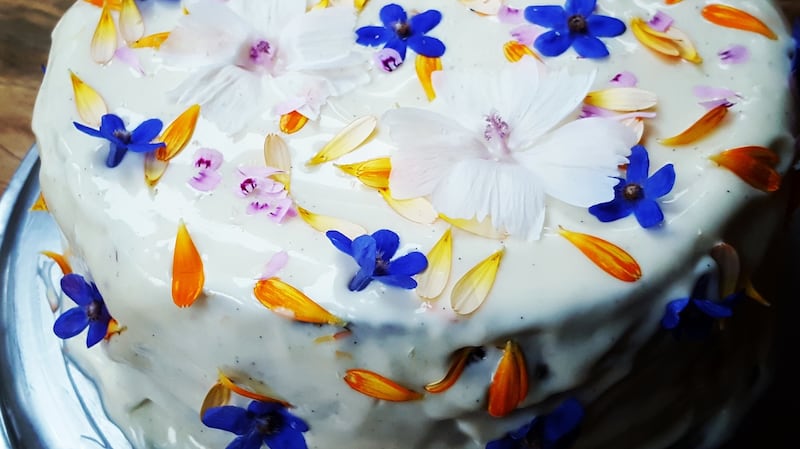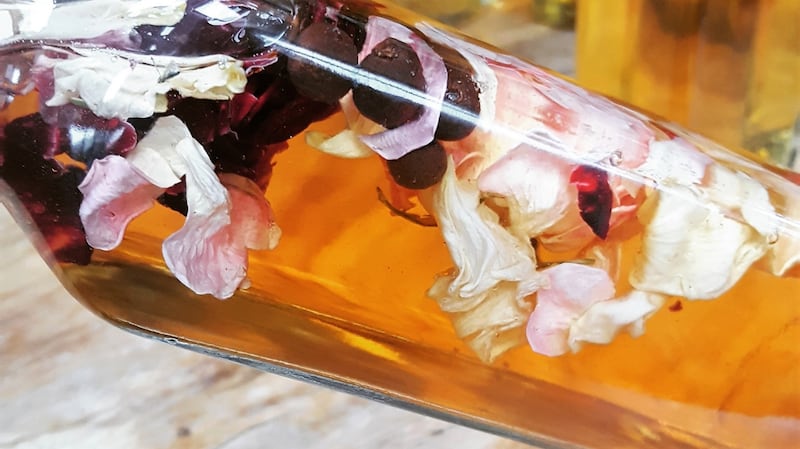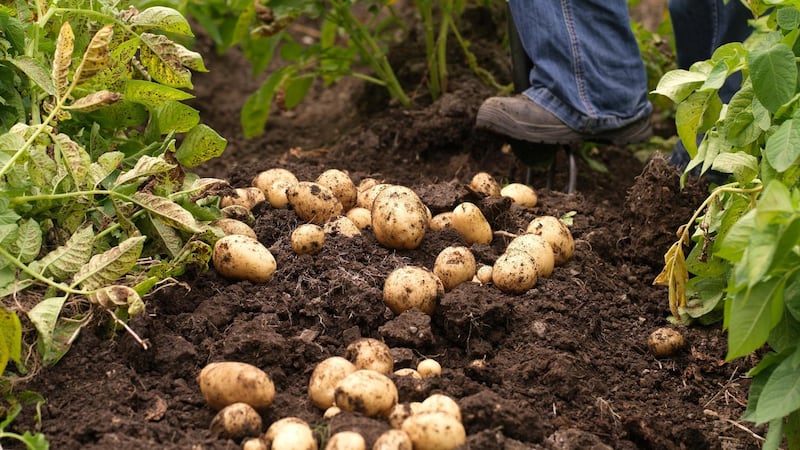Ever been tempted to sample the caramel-flavoured fruits of the common garden shrub known as the pheasant bush, to rustle up a tasty stir-fry of sliced dahlia tubers, or to add some crispy hosta leaves to a salad?
As the interest in unusual edibles continues to grow, a new and typically urban generation of gardeners is increasingly seeking out the sort of plants that make maximum use of their tiny plots in exciting and environmentally sustainable ways. Top of the list are the long-lived, wildlife-friendly perennial or shrubby kinds – the aforementioned pheasant bush (Leycesteria Formosa), dahlias and hostas are just some examples – that serve multiple uses in the garden, so that not only do they look good but that at least some part of them tastes good too.
The buzzword is "edimentals" (a portmanteau or blend of "edible" and "ornamental"), a term coined by the British-born gardener and author Stephen Barstow, whose excellent book Around The World in 80 Plants (Permanent Publications) highlights both the culinary, nutritious, and decorative possibilities of unusual edible perennials.


Here in Ireland, the Wicklow-based gardener Orlaith Murphy grows a wide range of edimentals in her tiny town garden – it measures just 18 square metres – in Newtownmountkennedy. A passionate cook, Orlaith's pretty but productive plot provides her young family with a cornucopia of delicious, nutritious, homegrown edibles that she uses as ingredients in homemade cakes, puddings, liqueurs, syrups, sauces, salads, stir-fries, jams and chutneys. "In a small garden like mine, every plant has to earn its place " she points out, adding that she makes full use of the growing space provided by the garden fences and house walls.
Flavour ice cream
Some of Orlaith's favourites are plants commonly found growing in Irish gardens. "The rose definitely comes in my top 10 for its beautiful, edible flowers which not only look and smell gorgeous but have so many culinary uses. I add the petals to salads or use them to make a rose-flavoured syrup (delicious trickled over a pudding), to flavour ice cream, or to decorate cakes." The daylily (Hemerocallis) is another common Irish garden plant that she prizes for its trumpet-shaped, edible flowers, which can be eaten fresh or dried in a kitchen dehydrator and stored for later use. This floriferous, easy-to-grow, hardy herbaceous perennial, which is happy in either sun or partial shade, is widely available in garden centres and typically blooms from late May-August. Flavour varies widely according to the species as well as flower colour; in her recently re-issued book The Salad Garden, Joy Larkcom recommends choosing daylilies with pale yellow and orange flowers for the sweetness of their succulent blooms.

Other favourites of Orlaith’s that can be found for sale in most garden centres include the old-fashioned garden pinks (Dianthus) – “I use their sweet, clove-scented flowers in the same ways that I use roses’ – as well as violas and sweet Cicely. “Sweet Cicely (Myrrhis odorata) is such a brilliantly versatile plant. You get this great froth of pollinator-friendly white flowers in late spring while you can add the aromatic, liquorice-flavoured stems, seeds and/or foliage to vodka and then leave it to steep to create a delicious sweet cicely schnapps. I also use it as a sugar substitute to sweeten rhubarb.”

More unusual edimentals have also earned a space in this sheltered, sunny Wicklow garden. Some, for example the evergreen sausage vine (Holboellia) whose clusters of scented, pale flowers are followed by decorative, edible, sausage-shaped fruits, and the chocolate vine (Akebia quinata) whose small wine-coloured, vanilla-scented flowers are also followed by delicious fruits, are still at the experimental stage as they require a long hot summer (or a polytunnel) to crop properly in Ireland. Others, such as the exotic summer-flowering plant known as tigridia – “The taste of its roasted bulbs is just out of this world!’ – or the evergreen, architectural shrub known as mahonia are among the mainstays of this Irish garden.
Good-looking plant
“I grow Mahonia ‘Charity’, which is such a good-looking, productive plant with plenty of seasonal interest. Its long-lasting spikes of yellow flowers appear in winter/early spring and are followed by blue-black berries that I use to make a savoury jam to drizzle over casseroles. Or I add them to apple-cider vinegar mixed with sugar to make a thirst-quenching ‘shrub’ drink.”.
Other edimentals that take pride of place in this small town garden include dahlias, oca (Oxalis tuberosa), udo (Aralia cordata), yacon (Smallanthus), mashua (Tropaeolum tuberosum), Cornus canadensis, Chilean guava (Myrtus ugni) and hollyhocks (Alcea rosea).
An experienced gardener and dedicated plant enthusiast with an RHS qualification under her belt, Orlaith sounds a note of caution regarding the proper identification of plants. "It's very important. I tell people to go with the Latin names to avoid confusion, and to eat something only if you're entirely confident that you've correctly identified it." She regularly gives classes on the subject of edimentals (one is planned for Hunting Brook garden in west Wicklow later this summer, see huntingbrook.com and Orlaith's own 'Urban Forager' Facebook page, @orlaithmmurphy ) while for those interested in some further research, she recommends checking out the fascinating book, blog and website of Stephen Barstow (edimentals.com) as well as those of gardeners Robin Harford (eatweeds.co.uk), Alan Carter (scottishforestgarden.wordpress.com), Martin Crawford (agroforestry.co.uk), Mark Diacono (otterfarm.co.uk), Plants For A Future (pfaf.org) and the specialist English plant nursery Edulis (edulis.co.uk).
This Week in the Garden…
The frost-hardy, sun-loving shrubby plant known as lemon verbena (Aloysia citridora), is another fantastic addition to the edible garden with slender, intensely lemon-scented/flavoured leaves that can be used to make a fragrant herbal tea, a delicious lemonade or a granita, or to infuse either vodka or gin. If you can give it a warm, sheltered spot, you’ll get away with growing it outdoors. Otherwise, grow this plant in a large pot for bringing under cover in winter, or in a polytunnel/greenhouse. Container-grown plants are readily available from most good garden centres and are fine to plant now as long as you keep them watered in dry spells.
Pots filled with summer bedding will soon start to run out of steam at this time of year unless you keep plants dead-headed and top up nutrients with a regular potash-rich liquid feed. Its also important to water these containers properly, using a garden hose or watering can-fitted with a rose head to generously soak the soil around the base of the plants while doing your best to avoid wetting foliage or flower buds. Pots or containers that have been allowed to completely dry out to the point of wilting should be partially submerged in a large bucket of tepid water until any air bubbles stop appearing, followed by a well-diluted liquid feed to replace lost nutrients.

*Potato blight increasingly becomes a risk at this time of year, especially during damp, humid weather. So pay attention to blight warnings (see met.ie) and watch out for signs of this damaging fungal disease, which include dark-brown patches surrounded by a pale “halo”, clearly visible on wilting foliage and stems. If blight does hit your crop, then cut the plants’ stems back to ground level and carefully dispose of them to help prevent the disease from spreading.
*Dates For Your Diary
Today (Saturday, 8th July, 2.30pm-5pm), Rathgar Horticultural Society’s 63rd Annual Flower Show, Christ Church Rathgar, adult admission €3, children free admission;
Saturday 15th July (10-1pm), Plein Air Painting/Drawing Workshop' with artist Mairead Byrne, Dalkey Garden School, Mornington Garden, Saval Park Road, Dalkey, Co. Dublin, fee of €50 includes refreshments;
Saturday 15th-Sunday 16th July, St Anne's Park Annual Rose Festival, which will include a farmers market, specialist plant sales

















